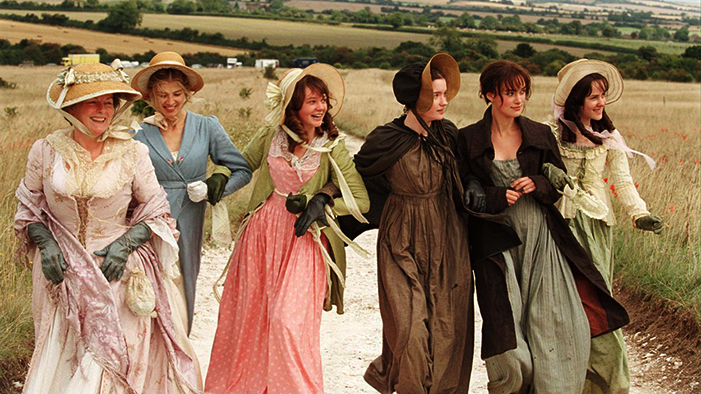At nyght were come into that hostelrye Wei nyne and twenty in a compaignye, Of sondry folk, by aventure yfalle In felaweshipe; and pilgrimes were they alle, That toward Caunterbury wolden ryde.
In these lines, the Narrator, or author, going by the name “Chaucer,” sets the scene. He is a pilgrim, staying at a hotel, when he encounters twenty-nine travelers on the same journey. The Narrator notes that the pilgrims are “sondry” or sundry, meaning coming from all walks of life. This diversity represents a major theme and innovation ofThe Canterbury Tales. The Narrator also describes the pilgrims as “in felawshipe” and “pilgrims were they alle,” emphasizing another theme: fellowship and commonality. In the lines that follow, the Narrator includes himself in this fellowship, saying, “I was of hir felaweshipe anon.”
And I seyde his opinion was good; What sholde he studie and make hymselven wood, Upon a book in cloystre alwey to poure, Or swynken with his handes, and laboure As Austyn bit? How shal the world be served? Lat Austyn have his swynk to him reserved!
The Narrator describes the Monk as preferring hunting and sport over his religious duties. Chaucer slyly agrees, calling books boring and useless. This is an ironic comment coming from the author, who of course spends most of his time at a writing desk. Such a comment also returns to a common theme in The Canterbury Tales: criticism of corrupt clergy. Chaucer may have been criticizing the Monk’s behavior or claiming that such behavior seems understandable—or both.
A bettre preest I trowe that nowher noon ys. He waitede after no pompe and reverence, Ne maked him a spiced conscience; But Cristes loore and his apostles twelve He taughte, but first he folwed it hymselve.
In the General Prologue, the Narrator sharply contrasts the Parson with the other clergy: the Summoner, the Pardoner, and the Monk. Unlike the others, however, the Parson practices what he preaches, caring for the poor and living a humble life. In the Narrator’s view, the corrupt clergy are condemned not just for sinning but also for their hypocrisy.
For this ye knowen al so wel as I: Whoso shal telle a tale after a man, He moote reherce, as ny as evere he kan Everich a word, if it be in his charge, Al speke he never so rudeliche or large; Or ellis he moot telle his tale untrewe, Or feyne thyng, or fynde wordes newe.
The Narrator wraps up the Prologue by warning readers of the lewd and rough tales ahead. He says that true storytellers must be honest and tell a tale exactly as they remember it. The rough language in The Canterbury Tales, so different from the Latin or French of “high” literature, presents a more honest reflection of the English people. Chaucer seems conscious that he bucks the literary traditions of the time by working in the vernacular.
’Hooste,’ quod I, ‘ne beth nat yvele apayd, For oother tale certes kan I noon, But of a rym I lerned longe agoon.’
In the Prologue to Sir Thopas, Chaucer interrupts the Host and then tells his own tale, the Talk of Sir Thopas. In these lines, he tries to avoid the telling, saying he doesn’t know any good stories besides an old rhyme he learned long ago. His warning to readers seems appropriate and honest, for he then offers an intentionally ridiculous poem about an absurdly perfect knight, Sir Thopas, who goes on a romantic quest. The prologue clearly describes this as an old story, identifying the tale as part of the stale literature that more lively works like The Canterbury Tales would soon replace.
His heer, his berd, was lyk saffroun, That to his girdel raughte adoun; Hise shoos of cordewane; Of Brugges were his hosen broun; His robe was of syklatoun That coste many a jane.
The Tale of Sir Thopas comes as a frothy, silly rhyme that often spends entire stanzas detailing the knight’s clothing, horse, armor, and weapons. Each object is described in loving detail, like a child recounting a favorite toy’s accessories. This process pokes fun at chivalric poetry in which every knight is handsome and rich and every lady is beautiful and pure. Eventually, Chaucer’s descriptions go on so long that the Host cuts off his endless story.
Now preye I to hem alle that herkne this litel tretys or rede that if ther be any thyng in it that liketh hem, that therof they thanken oure Lord Jesu Crist, of whom procedeth al wit and al goodnesse. / And if ther be any thyng that displese hem, I preye hem also that they arrette it to the defaute of myn unkonnynge and nat to my wyl, that wolde ful fayn have seyd bettre if I hadde had konnynge[.]
In the Retraction at the end ofThe Canterbury Tales, Chaucer apologizes to readers who were offended by the story. He asks them to credit the parts they liked to Jesus Christ and to blame the parts they didn’t on Chaucer’s own ignorance. This type of plea was common in Medieval literature, and it excused the author from accusations of sinful writing. As in many other parts of the story, Chaucer may be partly or entirely ironic. Chaucer clearly intended to write about ordinary people and criticize the Church. This so-called apology helps him cover all his bases with Church authorities.


 payment page
payment page



